Chris Howard's Blog, page 10
December 19, 2023
Galaxies in Ursa Major, wide-field view from my back yard of Bode’s Galaxy (M81, NGC 3031) and the…
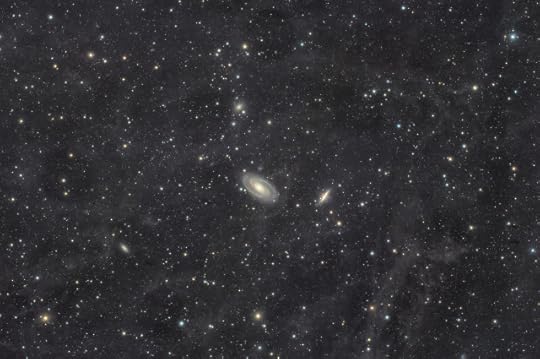
Galaxies in Ursa Major, wide-field view from my back yard of Bode’s Galaxy (M81, NGC 3031) and the Cigar Galaxy (M82, NGC 3034) about 12-million lightyears away in Ursa Major (the “Big Dipper”). There are a bunch of other galaxies in this view, including NGC 3077 and NGC 2976. The clouds and interstellar dust are in our galaxy and are lit by the surrounding starlight. Imaging Notes: 73 x 300-second sub-exposures taken with the William Optics Redcat 51 apochromatic refractor, ZWO ASI071MC color camera cooled to 0°C at Gain 0.
December 16, 2023
The Pleiades, M45, also called the Seven Sisters, is a very bright and distinct open star cluster in…
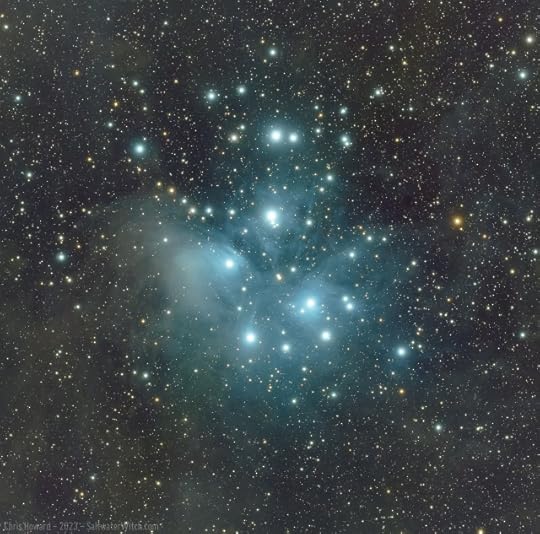
The Pleiades, M45, also called the Seven Sisters, is a very bright and distinct open star cluster in Taurus, surrounded by the reflection nebula NGC 1432 (most of that pale blue interstellar dust and cloudiness). The Seven Sisters are very hot blue stars about 444 lightyears away. Where I am in the northern hemisphere, around 43° latitude, the Pleiades rises in the night sky in October, peaks in January at almost 50° in the southern sky, before sinking below the horizon by the end of March—and then we don’t see it in the night sky again until late autumn.
To the ancient Greeks, over 2,500 years ago, the rising of the Pleiades marked the start of shipping season, when sailing the Mediterranean was a bit less dangerous. Like a lot of ancient mariners, Ancient Greek sailors and navigators relied on astronavigation, using the stars to determine their precise position on the surface of the earth. An ancient Athenian ship could leave the Piraeus and sail directly out to sea, then head west, toward Syracuse, tracking the stars the whole way to determine their course. They would also be keeping track of the Pleiades’ position in the sky each night, and use that to determine if they should pick up cargo and make the return trip or pick up some local coastal work through the summer and return to Athens in the fall.
Imaging Notes: 71 x 5-minute sub-exposures stacked in PixInsight. ZWO ASI071MC color camera cooled to 0°C, Gain 0, Antlia V-Series Luminance/UV-IR Cut filter, William Optics RedCat 51 Apochromatic Refractor 250mm FL, f/4.9, Sky-Watcher EQ6-R Pro mount, ZWO ASIAir Plus astro controller.
December 15, 2023
I setup the wide-field color rig at lunch and now I’m waiting for sunset. Going with the ZWO ASI071…
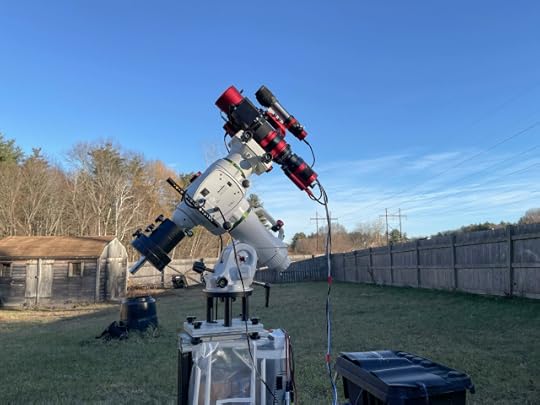
I setup the wide-field color rig at lunch and now I’m waiting for sunset. Going with the ZWO ASI071 cooled color (APS-C sensor) camera and an Antlia UV-IR cut filter. No moon tonight, so if we get a stretch of clear seeing, I’m going after M45 (the Pleiades) for half the night, and then I’ll spend the rest on M78 in Orion. Hope the weather holds!
More of my astro stuff here: https://www.saltwaterwitch.com
December 13, 2023
Orion Core in hydrogen-alpha: two-panel mosaic of Orion’s Belt, the Horsehead Nebula, and M42, the…
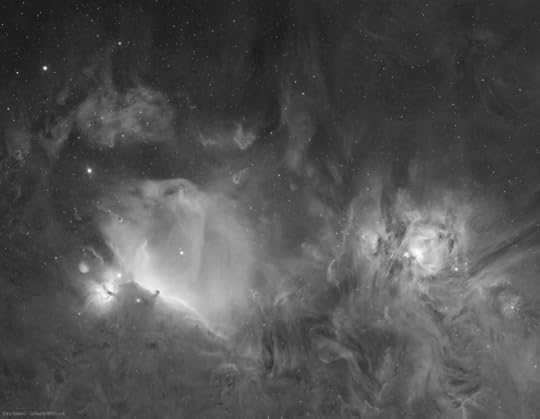
Orion Core in hydrogen-alpha: two-panel mosaic of Orion’s Belt, the Horsehead Nebula, and M42, the Orion Nebula–and everything going on around these. This is a big chunk of space and the center of the Constellation Orion. The three bright stars in a line on the left is Orion’s Belt. ZWO ASI2600MM-Pro, 3nm Ha, William Optics SpaceCat51 Apo refractor. My astro stuff here: https://SaltwaterWitch.com
November 24, 2023
Well, that worked pretty well for an 88% waxing moon with the ZWO ASI071MC color camera. The…
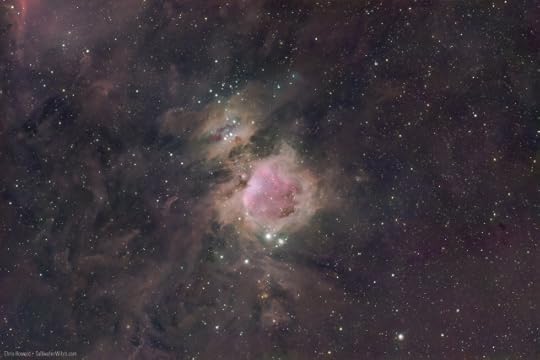
Well, that worked pretty well for an 88% waxing moon with the ZWO ASI071MC color camera. The near-full moon and Jupiter at opposition were just far enough away to make this set up work–plus a lot of 5-minute exposures. That band of red at the top left is the tail end of the ridge of hydrogen that runs behind the Horsehead Nebula (B33). Imaging notes: 63 x 300-second subs, no filters with the ZWO ASI071 color camera cooled to 0C, William Optics RedCat 15 Apo refractor, Sky-Watcher EQ6-R Pro mount. The Orion Nebula (M42), Running Man Nebula (Sh2-279), De Mairan’s Nebula (NGC 1982,M43), and surrounding nebulosity.
More of my astro stuff here: https://SaltwaterWitch.com
November 20, 2023
Flaming Star Nebula (IC 405, SH 2-229, Caldwell 31) and the Tadpole Nebula (IC 410) in the…
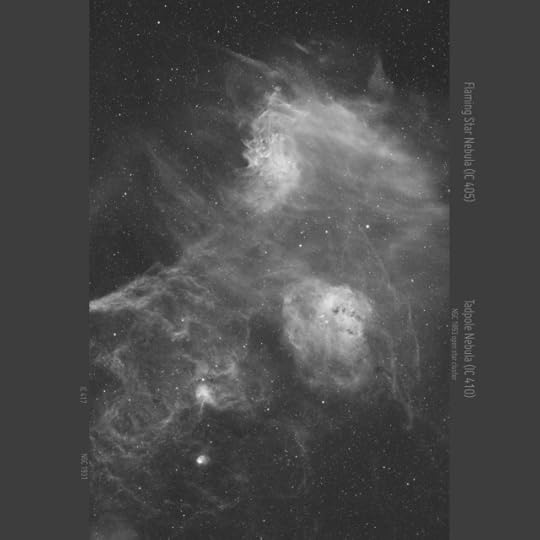
Flaming Star Nebula (IC 405, SH 2-229, Caldwell 31) and the Tadpole Nebula (IC 410) in the constellation Auriga, along with the two bright areas of emission toward the bottom, the “Spider and Fly”, IC 417 and NGC 1931. 42 x 300-second subs in hydrogen-alpha.
November 18, 2023
The Heart Nebula on the right (IC 1805, Sharpless 2-190) and Soul Nebula, left, (Westerhout 5 with…
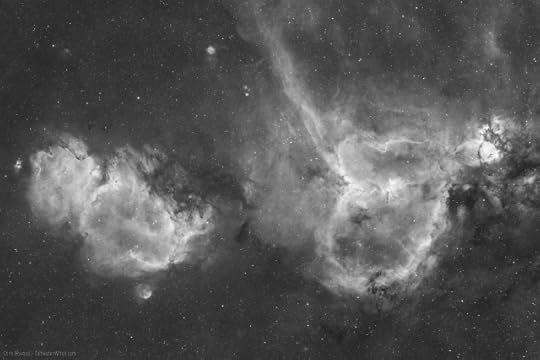
The Heart Nebula on the right (IC 1805, Sharpless 2-190) and Soul Nebula, left, (Westerhout 5 with the star cluster IC 1848) in Hydrogen-alpha. These two make up a massive star-forming complex in Cassiopeia about 7500 lightyears away in the Perseus Arm of our Galaxy. The bright emission nebula on the far right is the Fishhead Nebula (NGC 896, IC 1795). The small circular cloud, middle top, is another emission nebula Sh2-198, much further away, around 18,000 lightyears (still, well within the galaxy). The bright cluster of stars in the core of the Heart Nebula is Melotte 15.
Imaging Notes: 51 x 5-minute exposures stacked in PI, ZWO ASI2600MM-Pro monochrome camera cooled to -10C, 3nm Antlia Pro Hydrogen-alpha filter, William Optics SpaceCat 51 apo refractor, Sky-Watcher EQ6-R Pro mount. Shot from my backyard in coastal New Hampshire, bortle 4-ish.
November 17, 2023
The California Nebula (NGC 1499) about a thousand lightyears away in the constellation Perseus. I…
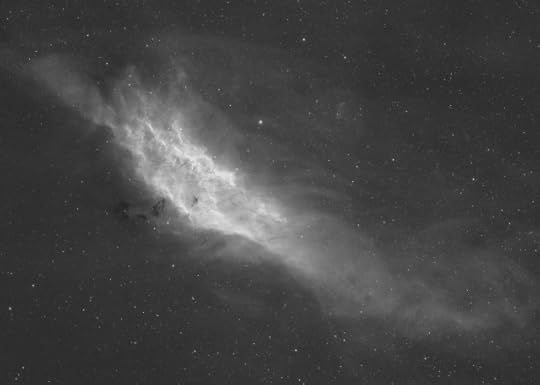
The California Nebula (NGC 1499) about a thousand lightyears away in the constellation Perseus. I will probably go after Sulfur 2 data next week–next clear night.
November 13, 2023
Orion’s Belt or the Three Sisters: next time you see that familiar line of three bright stars, the…
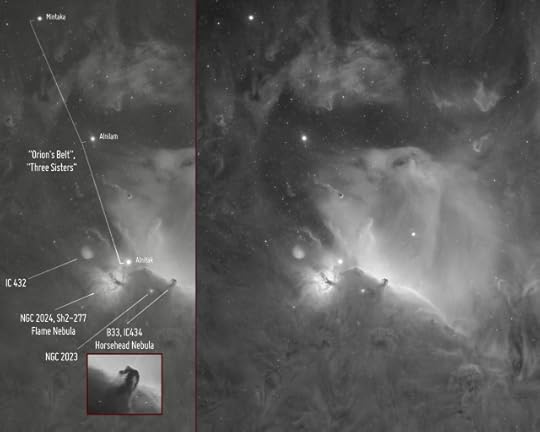
Orion’s Belt or the Three Sisters: next time you see that familiar line of three bright stars, the “Orion’s Belt” asterism at the center of the constellation Orion, imagine the backdrop of ionized hydrogen and all the other surrounding stuff you can’t see with your eyes, the bright nebulae, the dark structures of dust and molecular gasses, vast stellar nurseries with violent new stars forming out of trillions of kilometers of hydrogen clouds. There’s so much going on behind these three stars. The center of the Belt, Alnilam, is a single massive star, a supergiant that’s 375,000 times brighter than our star. Alnitak is a triple star system, and Mintaka is a binary star, with the two stars orbiting each other every 5.7 days.
Imaging Notes: 60 x 5-minute exposures stacked in PI, ZWO ASI2600MM-Pro monochrome camera cooled to -10C, 3nm Antlia Pro Hydrogen-alpha filter, William Optics SpaceCat 51 apo refractor, Sky-Watcher EQ6-R Pro mount. Shot from my backyard in coastal New Hampshire, bortle 4-ish.
November 12, 2023
Our giant neighboring galaxy, Andromeda (M31) in HaRGB. I captured this data last night, waiting for…
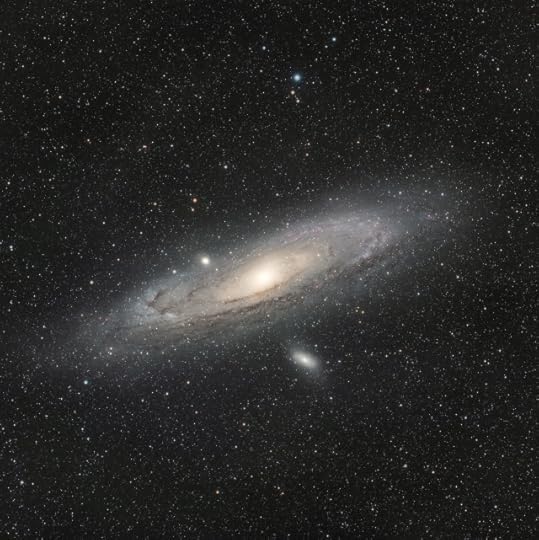
Our giant neighboring galaxy, Andromeda (M31) in HaRGB. I captured this data last night, waiting for Orion to rise above 30°. Imaging Notes: 30 x 120-second subs in RGB, 30 x 180-second subs in Ha stacked in PI, ZWO ASI2600MM-Pro monochrome camera cooled to -10C, Antlia Pro filters, William Optics SpaceCat 51 apo refractor, Sky-Watcher EQ6-R Pro mount. Shot from my backyard in coastal New Hampshire, bortle 4-ish.



